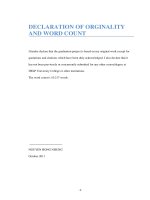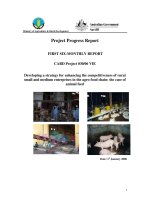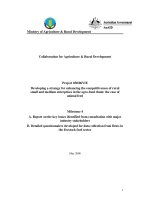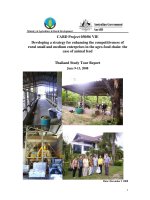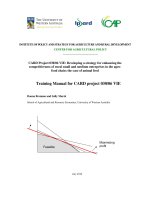Challenges in internationalisation for vietnam sme
Bạn đang xem bản rút gọn của tài liệu. Xem và tải ngay bản đầy đủ của tài liệu tại đây (600.77 KB, 79 trang )
ĐẠI HỌC QUỐC GIA HÀ NỘI
KHOA QUẢN TRỊ VÀ KINH DOANH
---------------------
ĐINH NGUYỄN BÍCH LÊ
CHALLENGES IN INTERNATIONALISATION
FOR VIETNAM SME
NHỮNG THÁCH THỨC TRONG Q TRÌNH QUỐC TẾ
HĨA ĐỐI VỚI CÁC DOANH NGHIỆP VỪA VÀ NHỎ Ở
VIỆT NAM
LUẬN VĂN THẠC SĨ QUẢN TRỊ KINH DOANH
HÀ NỘI - 2020
ĐẠI HỌC QUỐC GIA HÀ NỘI
KHOA QUẢN TRỊ VÀ KINH DOANH
---------------------
ĐINH NGUYỄN BÍCH LÊ
CHALLENGES IN INTERNATIONALISATION
FOR VIETNAM SME
NHỮNG THÁCH THỨC TRONG Q TRÌNH QUỐC TẾ
HĨA ĐỐI VỚI CÁC DOANH NGHIỆP VỪA VÀ NHỎ Ở
VIỆT NAM
Chuyên ngành: Quản trị kinh doanh
Mã số: 8340101.01
LUẬN VĂN THẠC SĨ QUẢN TRỊ KINH DOANH
NGƯỜI HƯỚNG DẪN KHOA HỌC: PGS.TS. HỒNG ĐÌNH PHI
HÀ NỘI - 2020
DECLARATION
The author confirms that the research outcome in the thesis is the
result of author‟s independent work during study and research period and it is
not yet published in other‟s research and article.
The other‟s research result and documentation (extraction, table,
figure, formula,
and other document) used in the thesis are cited properly
and the permission (if required) is given.
The author is responsible in front of the Thesis Assessment
Committee, Hanoi School of Business and Management, and the laws for
above-mentioned declaration.
Date…………………………..
i
ACKNOWLEDGEMENT
This research is dedicated to all people who are directly or indirectly
supporting me to successfully complete this work.
I would like to take this opportunity to extend my sincere thanks to
Vietnam National University, Hanoi/Hanoi school of business and
management (“HSB”) for their perfect and successful organization of this post
graduate course.
My great thank also convey to the professors and all
administrative staff of HSB for their valuable lectures and generous support
during the course.
I am grateful to Assoc. Prof - PhD Hoang Dinh Phi for his valuable
guidance from the beginning to the end of this work.
Finally, I am especially thankful for the love, encouragement, support
and patience of my partner throughout the research and writing process.
Hanoi, Date…………………………..
ii
TABLE OF CONTENT
DECLARATION ......................................................................................................... i
ACKNOWLEDGEMENT .......................................................................................... ii
ABBREVIATIONS AND ACRONYMS..................................................................... v
LIST OF TABLES ......................................................................................................vi
LIST OF FIGURE ................................................................................................... viii
CHAPTER 1: INTRODUCTION ................................................................................1
1. Background and Problem Statement....................................................................1
2. Objectives of the Study........................................................................................2
3. Scope of the Study ...............................................................................................2
4. Thesis Structure ...................................................................................................3
CHAPTER 2: LITERATURE REVIEW ....................................................................4
1. Conceptual Definitions of Internationalization ..................................................4
2. Internationalization and Competitiveness ..........................................................4
3. Internationalization and Resource-based View to Create Competitiveness ........6
4. The Role of Government in the Internationalization of SMEs ............................9
5. Government – Business Relations Models ........................................................10
5.1. Basic models of government-business relationship....................................11
5.2. Partnership Model of Organizing the Relationship between the
Government and Business .................................................................................12
6. Summary............................................................................................................14
CHAPTER 3: RESEARCH METHODOLOGY .......................................................15
1. Research Approach ...........................................................................................15
1.1. Induction or Deduction...............................................................................15
1.2. Qualitative and quantitative method...........................................................15
2. Research Strategy ..............................................................................................16
3. Literature Research ...........................................................................................17
4. Data Gathering ..................................................................................................17
4.1. Primary data of the research .......................................................................17
4.2. Secondary sources of data ..............................................................................18
iii
CHAPTER 4: FINDINGS AND DISCUSSION ........................................................19
1. Data Collection Description ..............................................................................19
2. Sample Description ............................................................................................20
3. Internationalization Process ..............................................................................21
3.1 Export activities ...........................................................................................22
3.2. Export and Import organization .................................................................24
3.3 Partnerships .................................................................................................25
3.4 Partnership content ......................................................................................28
4. Export Information and Assistance ...................................................................29
4.1 Utility provision ..........................................................................................32
4.2 Transportation facilities ...............................................................................33
4.3 Export promotion network support..............................................................34
5. Policy and Institutional Environment ................................................................36
5.1 Inspection visits received by firms ..............................................................38
6. Key Factors in Internationalization ...................................................................39
6.1 Impact of Ownership (SOEs and Private SMEs on all other factors) ..........39
6.2 Impact of Industry on all other factors .......................................................42
6.3 Factors impact on export shares ..................................................................45
6.4 Factors impact on International competitiveness .......................................48
6.5 Impact of key factors on effectiveness after international cooperation ......50
7. Summary............................................................................................................52
CHAPTER 4: CONCLUSION AND RECOMMENDATIONS ................................54
1. Reforming the credit system and developing the capital market ......................54
2. Reforming the trade policies to assist export activities by SMEs .....................56
3. Reforming further the customs procedures ......................................................58
4. Recommendations on technology policies ........................................................60
5. Recommendations on the operation of the organizations supporting SMEs .....60
6./ LIMITATIONS ................................................................................................62
Appendix I .................................................................................................................63
Appendix II................................................................................................................66
iv
ABBREVIATIONS AND ACRONYMS
CIEM
Central Institute for Economic Management
MPDF
Mekong Project Development Facility
ASEAN
Association of Southeast Asian Nations
AFTA
Asian Free Trade Association
WTO
World Trade Organization
ADB
Asian Development Bank
UNDP
United Nation Development Programme
VCCI
Vietnam Chamber of Commerce and Industry
UNCTAD
United Nation Conference on Trade and
Development
LESAFO
Leather and Footwear Association
VITAS
Vietnam Textile and Apparel Association
VASEP
Vietnam Association of Seafood Exporters and
Producers
VIETTRADE/MOT
Ministry of Trade
EU
European Union
VINAFRUIT
Vietnam Fruit Association
FDI
Foreign Direct Investment
SOE
State-owned Enterprise
SME
Small and Medium Enterprise
PSME
Private Small and Medium Enterprise
BOT
Building, Operating and Transferring
VND
Vietnam Dong
US$
United States of Dollars
v
LIST OF TABLES
Table 2.1: Roles and Models of Government in an Economy ..................................11
Table 3.1: Relevant situations for different research strategies ................................16
Table 4.1: Register capital and economic sector.......................................................20
Table 4.2: Distribution on industry ...........................................................................21
Table 4.3: Export motives of the SMEs ....................................................................22
Table 4.4: Export share ............................................................................................23
Table 4.5 ....................................................................................................................25
Table 4.6: Export channel ........................................................................................27
Table 4.7: Support from partners ..............................................................................28
Table 4.8: ...................................................................................................................28
Table 4.9: ...................................................................................................................29
Table 4.12: .................................................................................................................30
Table 4.13: Reasons for not using E-Commerce ......................................................31
Table 4.14 ..................................................................................................................32
Table 4.15: Difficulties in transportation ..................................................................33
Table 4.16 ..................................................................................................................34
Table 4.17 ..................................................................................................................35
Table 4.18 ..................................................................................................................36
Table 4.19 ..................................................................................................................37
Table 4.20 ..................................................................................................................38
Table 4.21 ..................................................................................................................39
Table 4.22 ..................................................................................................................42
Table 4.23 ..................................................................................................................42
Table 4.24 ..................................................................................................................44
Table 4.25 ..................................................................................................................45
Table 4.26: Correlation between export shares and other key factors (regression) ..45
Table 4.27: Correlation between International competitiveness and other key factors
(Regression) ..............................................................................................................48
vi
Table 4.28: Correlation between effectiveness after international cooperation and
other key factors (Regression) ..................................................................................50
Table 4.29 ..................................................................................................................52
Table 4.30 ..................................................................................................................53
vii
LIST OF FIGURE
Figure 2.1 ....................................................................................................................7
Figure 4.1 ..................................................................................................................24
Figure 4.2 ..................................................................................................................26
Figure 4.3: Application of E-Commerce ..................................................................29
viii
CHAPTER 1: INTRODUCTION
1. Background and Problem Statement
Small and Medium Enterprises (SMEs) of Vietnam play an important
role in the country's industrialization and modernization. The process of
economic reform in Vietnam, during the last few years, has directly impacted
and resulted in the growth of SMEs which has promoted the development and
diversification of trade, organization form and business areas through
internationalization. There is a plenty of reasons why small and medium
business should go international (VCCI, 2017), for example bigger markets
leading to bigger profits, cheaper supplies leading to more effective
production process. Most of them are market related, but one key factor is not
being, the type and quality of management.
Managers of exporting
enterprises show a higher degree of education and foreign language fluency
than those of non-exporting enterprises and are more dynamic when the
enterprises take the first step to the international market (MPDF, 2017).
In Vietnam, the development of SMEs towards internationalization,
however, is still limited (VCCI, 2017) due to market constraints and the
SMEs' competences. There are barriers such as capital shortage, old and
slowly renewed equipment, outdated technology, poor diversification of
product sample and lack of good skills and management experience. More
importantly, the lack of specific policies from the support institutions and
Government in promoting the internationalization of SMEs, enhancing
competitive advantages for SMEs apparently restricts their international
integration (VCCI, 2017).
Given this fact, there is an increasing body of studies and research
conducted by various international and local organizations, among whom
MPDF, UNDP, CIEM, VCCI and the World Bank are main actors. However,
1
while most of the studies on SMEs have put emphasis on general policy
recommendations, very few researches have focused on typical issues faced
by SMEs such as government support in export promotion. Therefore, the
purpose of this study is to point out obstacles faced by SMEs in international
activities and recommend strategy changes to answer the question: “How can
SMEs
in
Vietnam
achieve
effectiveness
when
engaging
in
internationalization?”
2.
Objectives of the Study
To explore current export barriers of SMEs in comparing with those
faced by state owned enterprises (“SOEs”);
To examine support policies and activities such as export promotion
activities from the government and professional association for SMEs;
To explore solutions or strategies that SMEs (in general and by group
such as PSMEs and SOEs) are using to resolve their barriers and the
effectiveness of their strategies;
To provide recommendation for both SMEs, Government and other
related stakeholders
The findings will be the basis for a possible model of government-
business relations in Vietnam and overall strategy by the Government towards
internationalization to achieve the most competitive advantages for SMEs.
3.
Scope of the Study
Content: The author focuses on the group of SME in the field of export
of garment products.
Timing: hard data collected from reports released during 2015-2018,
soft data collected during 2019
Space: the study and surveys were conducted within Hanoi, Bac Ninh,
Hai Phong.
2
4.
Thesis Structure
Chapter 1: Introduction
Chapter 2: Literature Review
Chapter 3: Research Methodology
Chapter 4: Data Analysis and Finding Discussion
Chapter 5: Conclusion and Recommendations
Appendices
3
CHAPTER 2
LITERATURE REVIEW
1. Conceptual Definitions of Internationalization
Internationalization can be described as the process leading to a
company's increasing involvement in cross-border or international operations.
Internationalization is an organic process, but, at any given point in time, a
company‟s degree of Internationalization may be measured. Typical
measurements are export quota; number of markets; foreign investment quota;
number of foreign subsidiaries, and management orientation. (Meyer, 2016).
Internationalization of a company refers to the increase of all crossborder business activities. These include exports but also link to foreign
supplies of raw materials, components, machinery, donors, and international
financial institutions.
Small and medium enterprises have many disadvantages compared
with large enterprises even in the domestic market. Management skills and
technology are limited to their knowledge, and understanding about different
cultures and effects of institutions is also limited. Moreover, they do not have
many advantages of assets, resources, co-operations with partners both
domestic and foreign ones. It can be seen that the competitive advantages of a
firm are influenced by the interaction of the business community of the
country and the industry which the firm belongs to.
2. Internationalization and Competitiveness
Internationalization is an important way to gain and maintain
competitiveness in an open economy. The benefits that Vietnamese late
followers will get are the shortcut to upgrade technology through international
technology import and international linkages. Cooperative partnership
relations between firms can be an effective vehicle to get access to scarce
4
resources for the local firm. Upgrading through own research and
development efforts will both be costly and time consuming. Unless human
capital and skills are upgraded, production may be limited to exploiting
comparatively low cost labor. Domestic savings alone cannot finance
necessary investments in technology development and human capital.
Tapping into international resources for capital, technology and human skills
is an important option. How to do that effectively and gain competitiveness is,
however, not simple and require carefully framed strategies both at country
and firm level (Lall, 2009; UNCTAD, 2008).
While different kind of mechanisms both at country and firm level can
be thought of to strengthen competitiveness, the linkages that are forged in a
cooperative partnership between firms can transfer scarce resources and
benefit all partners in the alliance. While competition between firms
stimulates competitiveness and upgrading it is also possible through
cooperation between firms (Porter, 2008). International linkages are voluntary
inter-firm agreements aimed at achieving competitive advantage for the
partners (Das, 2008).
When international linkages are formed between firms across borders,
it opens the possibilities to exchange resources that are difficult to obtain in
the domestic environment or to acquire internationally on commercial terms.
An important element for going into cooperative arrangements for the firms is
the notion that it will save transaction costs compared to other forms of
exchange. Internationalization through such international linkages like
strategic alliances can, however, also be seen from a resource based
perspective where the firm is essentially understood through the resources it
has at its disposal. International linkages are driven by the need for resources
through cooperative interaction and integration between firms (Das, 2008;
Faulkner, 2012). In alliances it may however not only be a question of
5
obtaining but also of retaining resources. This leads to considerations of the
learning organization as important for the rationale and sustainability of
strategic alliances (Faulkner, 2012). Furthermore, elements of strategic
behavior models and game theory; social relations and network theory; and
power-dependency theory add additional perspectives to understand strategic
alliances and how they work.
The strategies pursued in cooperative ventures may take various paths:
a. Market development and expansion; b. research and development
partnerships; c. international production sharing/sub-contracting and d.
counter-trade alliances (Culpan 2011). These strategies can also be combined
and shaped in relation to the needs of the parties. While large multinational
firms may join into alliances of a horizontal nature, the vertical cooperation
between a producer and its sub-supplier may often involve quite different
firms with respect to size and resources and thereby power in the relationship.
3.
Internationalization
and
Resource-based
View
to
Create
Competitiveness
Creating sustainable private sector development can be hypothesized to
hinge significantly on the ability of Vietnamese industry to foster
international linkages. The importance of internationalization is emphasized
by the industrial organization literature on competitive advantage. Vietnam
has chosen a development strategy based on an open economic regime. Free
flows for international trade and capital flows will increasingly be part of the
conditions under which policies are formulated and firms are operating.
Regionally, the integration will increase not the least in relation to
ASEAN/AFTA and the huge neighboring economy of China. Internationally
the bilateral trade agreement with USA is in place as a likely forerunner for
Vietnam membership in WTO (World Bank/ADB/UNDP, 2017). All these
constitute important opportunities for Vietnamese firms, but they also
6
represent critical challenges for these firms to participate in international
competition and achieve competitiveness.
Therefore, the question is how to build up competences for Vietnamese
firm especially SMEs which account for more than 90% of all the Vietnamese
firms of all sizes (Ministry of Planning and Investment, 2017). It can be seen
that, with such small scale in size and activities scope, SMEs in Vietnam
really need the support from the government in building up overall strategies
as per industry. The role of the Government is hypothesized as adhering and
categorizing all the SMEs based on their different resources and competences
so that it can create policies accordingly aiming at the highest international
competitiveness for the firms. In this part, the resource-based theory and
activities of the firm along the value chain are discussed as a basis to group
the firms‟ resources.
Figure 2.1
Firm Resources to be grouped
(Resource–based theory)
Categorizing and grouping
Resources owned in
Upstream activities
Resources owned in
Downstream activities
Upstream internationalization
Downstream internatiolization
Procurement & Logistic & Production........Marketing & Services
Value chain
(self-constructed) FIRM RESOURCES AND INTERNATIONAL
COMPETITIVE ADVANTAGES
7
Understanding sources of sustained competitive advantages for firms
has become a central issue in strategic management. Most of the theories
suggest that firms obtain sustainable competitive advantages by implementing
strategies that exploit their internal strengths through responding to
environmental opportunities while neutralizing external threats and avoiding
internal weaknesses (Hofer & Schendel, 1997). Recently, most of the work
has tended to focus primarily on analyzing firm‟s opportunities and threats in
its competitive environment. As Porter‟s (2008) five forces model describes
the attributes of an attractive industry and thus suggests that opportunities will
be greater and the threats less.
However, Porter‟s model has been criticized for its neglect of the
competencies and other internal conditions that influence the development of
firms‟ competitiveness. Critics claim that externally focused orientation
cannot be a secure basis for developing non-imitable resources and
competitive advantage (Grant, 2015 and Barney, 2015). The problem is that
the Porter diamond appears to conceive competitiveness as exogenously
conditioned thereby ignoring the internal conditions (e.g. firm level resources)
that promote competitiveness of firms. This critique is in particular voiced by
the “resource-based view” of the firm (Foss, 2015).
The resource-based view has recently emerged as an alternative
approach understanding industrial organizations and their competitiveness
strategies. The resource- based view of competitive advantage focuses more
on internal factors and examines the link between firm‟s internal
characteristics and performance, that obviously can not build up only on
external factors (Barney, 2015). It suggests that the rationale for international
linkages is the value creation potential of firm resources that are pooled
together. Firm resources here include all assets, capabilities, organizational
8
processes, firm attributes, information, knowledge, etc. controlled by a firm
that enable the firm to conceive of and implement strategies that improve its
efficiency and effectiveness.
The resource based view of firms assumes that firms within an industry
(or group) may have the same resources with respect to the strategic resources
they control and these resources may not be perfectly mobile across the firms
and thus they can be built up as competitiveness.
4. The Role of Government in the Internationalization of SMEs
According to Porter (2016), the development of competitiveness is
influenced by government policy in that facilitates the conditions within each
of the four facets of the diamond as well as their interaction. The role of
Government in adhering all the businesses and creating industrial
competitiveness and national competitiveness is important more than ever in
fewer developing countries. Trade policy issued by the Government thus
should not passively respond to complaints or to those industries that can
muster the most political clout but must seek to open markets wherever a
nation has competitive advantages. Government policies and measures are
particularly important in developing countries, where private sector
development often is in its infancy (Esser, 2014 and Whitley, 2014). What
should be done is to identify such programmes and instruments that have
facilitated competitiveness enhancing linkages between local enterprises and
foreign partners in developing countries. For instance, as the type, strength
and effects of local-TNC linkages to a large extend depend on technological,
financial and other resource capabilities of local industry, it is essential to
identify instruments and programmes that have succeeded in nurturing such
capabilities. Or, as the competitiveness of local industry in an international
context largely depends on industrial clusters and chains becoming integrated
internationally, it will be essential to identify those government policies and
9
programmes that facilitated successful collaborations. Obviously, the analysis
of these specific programmes must take into account overall economic
conditions and frameworks, by controlling for the effect of factors such as
macro economic stability and degree of openness of trade and investment
regimes.
Regional experiences in Asia have shown that the balance between the
role of the state and the SMEs is very crucial for expansion in an exportoriented strategy. Most experiences point at the crucial role of the state.
However, it is also evident that this role has taken different directions in the
export-oriented countries around Vietnam.
5. Government – Business Relations Models
In this study, the concept of „businesses‟ or „business community‟ refers
to all commercialized and profit-making oriented entities including either
private firms or stated-owned enterprises (SOEs).
In contrast, „government‟ refers to policy and law making agencies,
government‟s facilitating and implementing institutions and the public
administrative apparatus. This distinction aims at excluding SOEs from the
policy making and facilitating body of Vietnamese Government, which is
subject to many recommendations of this research.
By relationship between government and business, it means some
degree of dependency or interdependency between the two actors. The
relationship can be looked upon from a structural point of view, i.e. how is the
relationship organized, or from a behavioral point of view, i.e. how do the
actors interact. Both views are relevant but within a government-business
framework, the interaction and the activities are of primary interest. It is
through the action and interaction that the relationship between government
and business develops and a learning process is put in motion.
10
5.1. Basic models of government-business relationship
Over the years, numerous views on the nation state and the relationship
between the government and the business community have been formulated.
As the world today is more colorful, the question is not central planning
versus market supremacy and the concomitant role of the government. The
question is the merits of each of several alternative ways of managing and
governing a market economy.
This study has identified five different models of the role of
government in relation to the business community. The models are
summarized in the Table 2.1.
Table 2.1: Roles and Models of Government in an Economy
Type of government
Laissez-Faire
Public Authority
Private Autonomy
(Public Sector)
(Private Sector)
Minimize
Maximize
Division of labor between Government and
Mixed Economy
private sector based on effectiveness and
efficiency
Dialogue between Government and private
Partnership
sector, the dialog taking place within a network
of public and private institution
The government represents unified political
Public Policy Supremacy
power and through policies, the government
shapes or directs the action for the private
business
Central Planning
Maximize
Source: Sorensen (2012)
11
Minimize
The lassez-faire model or neoclassical economics model of government
business relations has the stands that the government which governs least. The
public authority should be minimized and the private autonomy maximized. In
relation to the economy, the role of Government is assuring the proper working of
the markets both the domestic and the international ones. Those roles are more to
do with maintaining macroeconomic stability and supplying public goods.
In the mixed economy model, a given sum of function to be preformed by
the public authorities or autonomous private entities is envisioned. The main issue
is to define the borderline between the two sectors. The guideline for defining the
borderline is the efficiency with which each of the two sectors can perform the
functions. The guideline is again linked to welfare considerations. In general, the
role of the government embedded in the concept of the mixed economy can be
found in many economies but lots of variants exist.
In the central planning model, the government is the dominating actoractivist or entrepreneur who plans and carries out the economic functions. The
model assumes that preferences and resources are known and that bounded
rationality does not exist. The private sector is minimized, if existing at all.
Often the government is hostile towards private sectors, seeing the capitalist
threat in even micro enterprises which barely survive from their business.
5.2. Partnership Model of Organizing the Relationship between the
Government and Business
Basically,
the
partnership
model
represents
an
institutional
arrangement between the government and the business community, which is
able to handle a multiplicity of interests through interaction involving
dialogue, negotiations and actions. This model has following basic features:
1.
The principal actors are the private firms and their associations, the
political bodies and the public agencies.
12
2.
The actors interact and through the interaction, intensive and often
personal and long-term relations are developed.
3.
The relationship may be formalized by establishing specific institutions.
4.
The actors are not seen as unified decision makers but are characterized
by a multi-center power structure.
5.
In its pure form, the partnership model is characterized by
interdependence, trust, cooperation, and mutuality in the relations
between government and business.
6.
Being political/economic institutions, the activities within the
institutions aim at fulfilling ideological, strategic and practical
objectives.
The activities comprise: Policy formulation activities;
Campaigning activities; Discourse activities; Dialogue activities; and
Implementation activities. Some of those types of activities may be
dealt with in specialized institutions, and at the same time, the same
institutions may be in charge of more than one activity. Those activities
can be summarized as follows:
Policy formulation
The formulation and analysis of
problems and the proposal of solutions
Campaign activities
The formulation and diffusion of the world
views held by the institution in question
Discourse activities
Testing the rationale of policies and world
views
Dialogue/Negotiations
Establish procedures/Terms of reference and
discuss and formulate compromises
Implementation activities
Carry out, monitor, punish violators and
reward compliers.
Basically a partnership model driven by interdependence and mutual
understanding between public and private sectors is characterized by actions
based on information exchange, communication, dialogue, and negotiations
13
within a network of personal and institutional relations. The interaction is
intensive, frequent and takes place between organizations or within
overlapping organizations established in conjunction by the two sectors.
6. Summary
Issues related to internationalization play as a basis for overall
understanding of SMEs internationalization. While stage theory helps
studying where Vietnamese SMEs are and where they should move to in the
internationalization, network theory emphasizes on importance and
advantages of business linkages among SMEs in one industry, one nation and
in global network. Government-Business relations apparently influence the
effectiveness of internationalization of SMEs and also help to enhance the
export promotion system in Vietnam in supporting SMEs.
14
CHAPTER 3
RESEARCH METHODOLOGY
1. Research Approach
The research approach consists of the inductive or deductive way of
drawing conclusions, and the qualitative and/or quantitative method of
investigating information. I will describe the different approaches and justify
the choices I have made.
1.1. Induction or Deduction
Two different approaches for drawing research conclusion exist, that is,
induction or deduction (Wiedersheim-Paul & Ericksson, 2009). The inductive
approach means that the researcher, by observing the reality, acquires
generalisable data, from which theories are formed (Ericksson & WiedersheimPaul, 2015). I have assumed the deductive approach in my thesis, since I have
proceeded from existing theories and models regarding the export development
process. These theories have been tested empirically, to see if they correspond to
the reality. I have chosen this research approach since many theories in the area
exist, although based on large enterprise‟s experiences.
1.2. Qualitative and quantitative method
Depending on the kind of information that is investigated, either
qualitative or quantitative method is used (Lekvall & Wahlbin, 2013).
Qualitative method does not strive to generalise the problems; instead, the
purpose is to give a deeper understanding of the problem. Further, the method
is flexible, and thereby, the researcher can correct possible weaknesses and
incorrect formulations, and also add lacking questions.
However, one
weakness with this method is that, it can be a problem to compare information
from the different objects of study (Holme & Solvang, 2015). Qualitative
investigations usually take the form of case studies or surveys, with few
research objects (Lasvall & Wahlbin, 2011).
15

